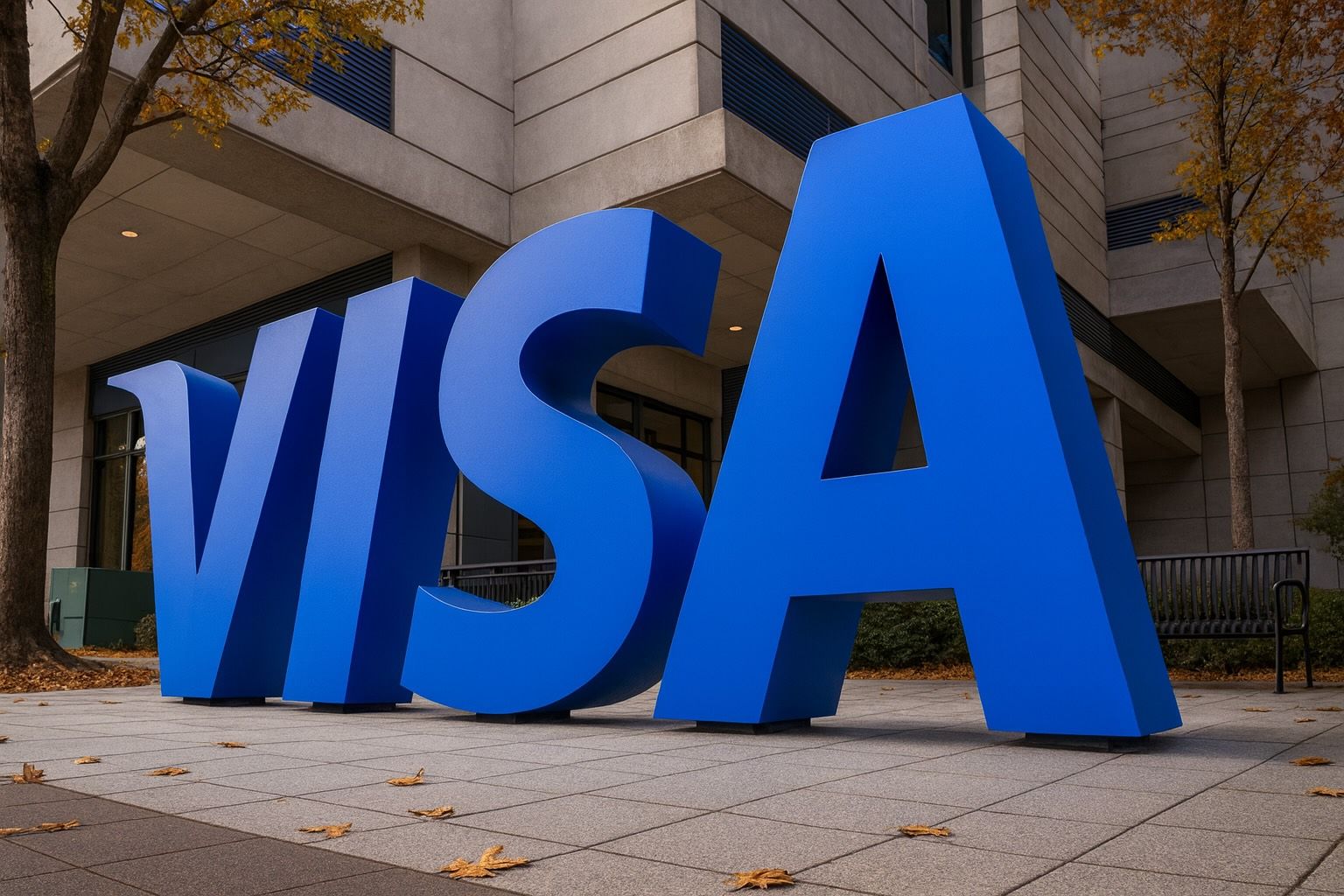Summary: Visa shares closed Friday at $336.02, about 10.5% below their 52‑week high. Over the weekend, reporting indicated Visa and Mastercard are nearing a settlement with U.S. merchants that would modestly reduce interchange fees—an overhang investors will weigh alongside Visa’s strong fiscal Q4 results, a higher dividend, and low‑double‑digit growth guidance for FY2026. [1]
KEY POINTS AT A GLANCE
• Last close (Nov 7): $336.02; 52‑week range: $299.00–$375.51. [2]
• Weekend headline: WSJ reporting (via Reuters) says Visa and Mastercard are close to a settlement with merchants that would trim swipe fees ~0.10 percentage point over several years and ease “honor‑all‑cards” rules. Both companies declined comment. [3]
• Q4 FY2025 (reported Oct 28): Net revenue +12% to $10.7B; GAAP EPS $2.62 (impacted by an $899M litigation provision); non‑GAAP EPS $2.98. Dividend lifted 14% to $0.67. Buybacks totaled $4.9B in Q4; $24.9B authorization remains. [4]
• Guidance: FY2026 adjusted net revenue growth expected in the low double digits; Q1 adjusted net revenue growth at the high end of low double digits; adjusted EPS growth in the low double digits. [5]
• This week: Ex‑dividend date and record date listed as Nov 12; payable Dec 1. CFO Chris Suh speaks at KBW’s Fintech Payments Conference on Nov 12. [6]
THE PRICE ACTION
Visa finished Friday at $336.02, −0.28% on the day. That puts the stock about 10.5% below its 52‑week high of $375.51 and comfortably above its 52‑week low of $299.00—levels investors often use as context for sentiment into a new week. [7]
THE WEEKEND HEADLINE TO WATCH
Reuters reported that Visa and Mastercard are nearing a settlement with U.S. merchants in a long‑running dispute over credit‑card fees and acceptance rules. According to the report, the contemplated deal would reduce interchange fees by roughly a tenth of a percentage point over several years and give merchants more leeway to decline certain card types. While details could still change, any agreement that nudges fees lower and modifies acceptance rules would be parsed for potential effects on premium rewards economics, merchant steering, and network incentives. [8]
EARNINGS CHECK: SEPTEMBER QUARTER SNAPSHOT
• Revenue & EPS: Fiscal Q4 net revenue rose 12% to $10.7B. GAAP EPS was $2.62, weighed by an $899M litigation provision tied to the interchange MDL and other legal matters; non‑GAAP EPS was $2.98. For FY2025, net revenue grew 11% to $40.0B; non‑GAAP EPS climbed 14% to $11.47. [9]
• Business drivers: Payments volume +9% (constant‑currency), total cross‑border +12%, processed transactions +10% in Q4. Value‑added services continued to outgrow the core network. [10]
• Capital returns: Visa repurchased ~$4.9B of stock in Q4 and had $24.9B left on its authorization at Sept. 30. The board raised the quarterly dividend 14% to $0.670 per share (payable Dec 1 to holders of record Nov 12). [11]
WHAT MANAGEMENT GUIDED FOR FY2026 (AND Q1)
On the Oct. 28 call, CFO Chris Suh said Visa expects FY2026 adjusted net revenue growth in the low double digits and adjusted EPS growth in the low double digits, assuming a steady macro backdrop and business drivers near Q4 levels. For Q1 FY2026, management expects adjusted net revenue growth at the high end of low double digits and adjusted EPS growth in the low teens. Suh also flagged that Q1 should see the strongest year‑over‑year net revenue growth rate due to pricing timing, while Q3 could be the softest comp. Marketing expense will be elevated in Q2–Q3 around the 2026 Olympic and FIFA events. [12]
DIVIDEND & DATES
Visa’s new quarterly dividend is $0.67 per share. Several major trackers list Nov 12, 2025, as the ex‑dividend and record date, with payment on Dec 1, 2025. If you’re trading around the ex‑date, confirm your broker’s settlement cutoffs. [13]
NEAR‑TERM CATALYSTS THIS WEEK
• Wednesday, Nov 12: CFO Chris Suh presents at the KBW Fintech Payments Conference (8:40 a.m. ET), where any commentary on pricing, incentives, cross‑border trends, and the reported merchant settlement could move the stock. Replay will be available on the IR site. [14]
• Ongoing: Watch for formal updates on the merchant‑fee litigation/settlement front and merchant steering rules—topics that could influence sentiment for both Visa and Mastercard. [15]
STRATEGY & COMPETITIVE CONTEXT
Beyond the core network, Visa keeps leaning into value‑added services, commercial payments (Visa Commercial), and money movement (Visa Direct). Management highlighted 25% constant‑currency growth in value‑added services in Q4 and continued investment in AI, fraud prevention, tokenization, and even stablecoin capabilities to expand Visa’s “network of networks” and product stack. These areas can help diversify revenue and deepen client relationships, cushioning the impact of cyclical spending or fee headlines. [16]
PARTNERSHIP THREADS TO NOTE
Last week, Visa announced a collaboration with Transcard to deliver embedded working‑capital solutions for freight and logistics via WebCargo by Freightos—one of several recent moves aimed at scaling commercial and embedded finance use cases. While not a near‑term earnings swing factor, it shows where Visa is pushing for incremental growth outside consumer swipe volume. [17]
VALUATION SNAPSHOT HEADING INTO THE OPEN
Using FY2025 non‑GAAP EPS of $11.47 and Friday’s close at $336.02, Visa trades around 29.3x trailing non‑GAAP earnings. With shares ~10.5% below the 52‑week high and FY2026 guidance calling for low‑double‑digit top‑ and bottom‑line growth, investors will balance that multiple against the durability of wallet share, cross‑border normalization, and any fee‑rule changes that emerge from the merchant case. [18]
RISK CHECK
Watch the trajectory of U.S. consumer spending, travel‑related cross‑border volumes, and any finalized details around merchant acceptance rules or interchange that could weigh on premium‑rewards economics or incentives over time. Also keep an eye on litigation accruals—the Q4 GAAP hit underscores that legal outcomes can add noise to reported results even when underlying drivers are healthy. [19]
BOTTOM LINE
Into Monday’s open, Visa has: (1) resilient fundamentals and low‑double‑digit growth guidance; (2) a higher dividend and significant buyback capacity; and (3) a new legal headline to monitor that could modestly pressure economics over several years if a settlement is finalized. For most long‑horizon holders, the focus remains the same: payments volume, cross‑border momentum, value‑added services growth, and disciplined capital returns. Short‑term traders will zero in on any settlement confirmation and fresh commentary from Wednesday’s KBW appearance. [20]
Disclosure: This article is for information only and is not investment advice. Always do your own research.
References
1. investor.visa.com, 2. investor.visa.com, 3. www.reuters.com, 4. www.sec.gov, 5. investor.visa.com, 6. www.morningstar.com, 7. investor.visa.com, 8. www.reuters.com, 9. www.sec.gov, 10. s1.q4cdn.com, 11. www.sec.gov, 12. investor.visa.com, 13. www.morningstar.com, 14. usa.visa.com, 15. www.reuters.com, 16. investor.visa.com, 17. usa.visa.com, 18. s1.q4cdn.com, 19. www.sec.gov, 20. investor.visa.com







